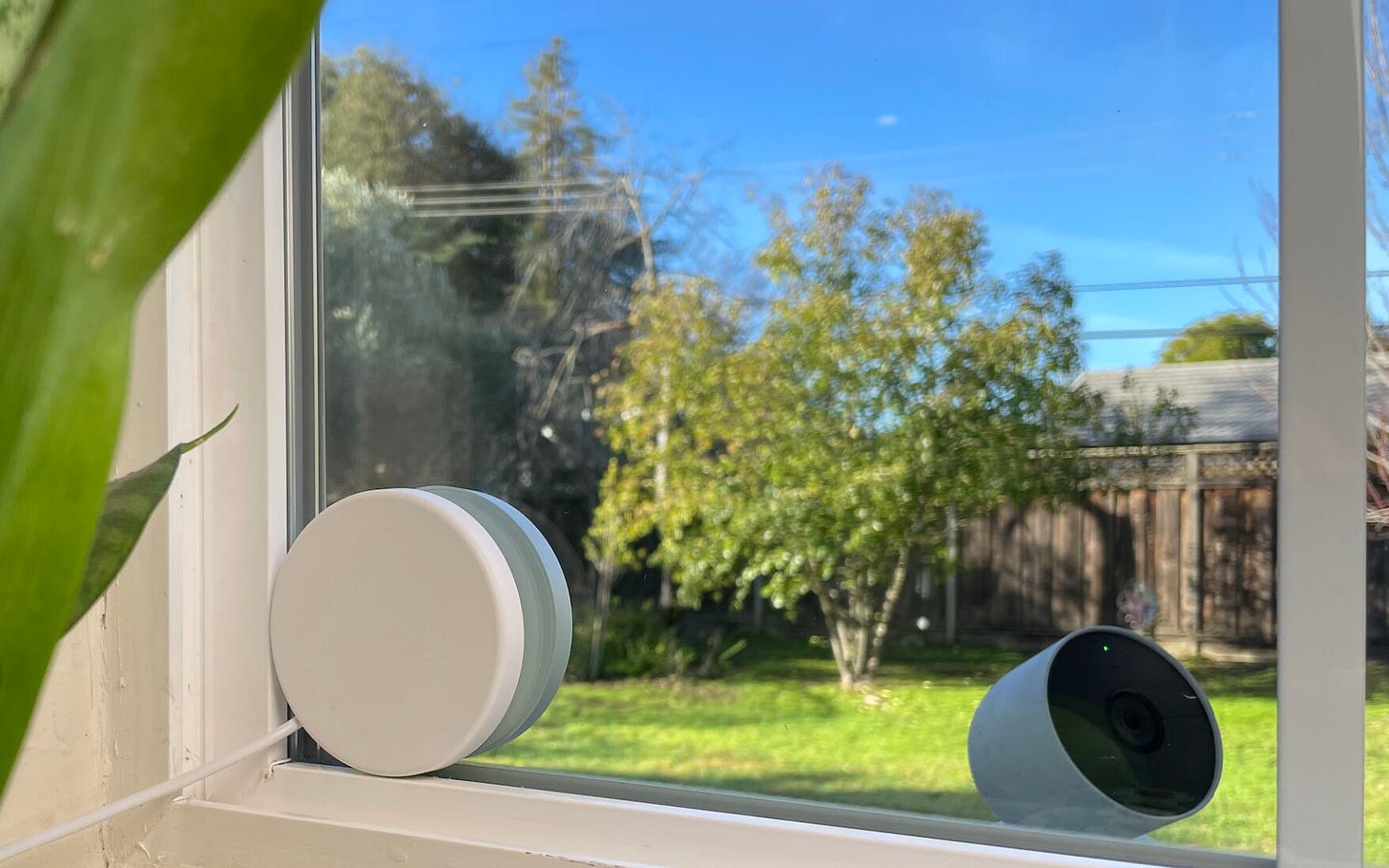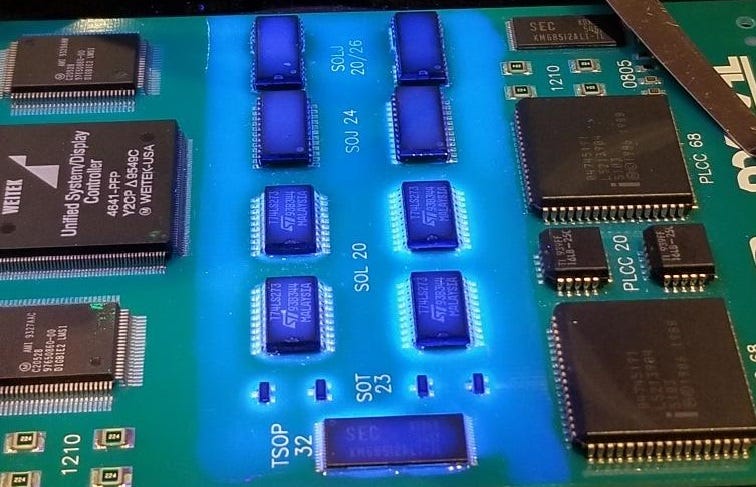We’re hosting a workshop on 6/26 with a molding expert from Fictiv on how to spot common injection molding defects and design around them. Sign up here!
Onshape is offering hardware startups and entrepreneurs free access to Onshape Professional—complete with CAD, rendering, simulation, PDM, and more. Apply for the program to get started today.
Interesting Links 🏭
What happens when an internal Google R&D project gets canceled? Sometimes you just build it anyway. Case in point: Peter, an antenna engineer at Google Nest, pitched the idea of wirelessly powering outdoor Nest cameras through windows. (If we were to guess, the market was probably too niche for Google’s scale.) He ended up building it as a solo side project, and the result is a great case study in how to ship hardware with minimal resources. He used FreeCAD for the enclosure and ran 30+ print iterations before tooling. PCBs were designed in Eagle and fabbed through OSHPark. Firmware was written in C using STM’s Standard Peripheral Library (SPL) and flashed with a $5 ST-Link debugger, running on the cheapest STM8 MCU he could find on Digikey. The result is the Power Mole, a home-built system that wirelessly delivers 11W of power through glass (up to 36mm thick), enough to run 5V devices like Nest Cams and USB lights.
The great part about a one person team is whenever there's a conflict between the industrial designer and the mechanical guy, or the firmware and EE guy, it was always the same person. So no meetings required. I guess the moral of the story is to keep your teams small.
Note: A more industrial take on the same idea is the Bridge XC, which delivers 30W of power and 1Gbps of data through glass using LiFi (infrared light instead of RF). It’s aimed at networking and infrastructure applications. Full patent here.

On a related note: this series of essays on hardware development offers one of the clearest looks into how consumer products actually get built at large companies (think Apple, AmazonLab126, Google). Before engineering kicks off, development begins with validating the product concept through a PRFAQ process (Press Release + Frequently Asked Questions—yes, it’s a mouthful). The PRFAQ forces clarity on who the customer is, why the product matters, and whether it’s even viable. The PRD (Product Requirements Document) then captures what exactly to build, what the constraints are, and how success is defined. Bolt also has a simple PRD template—they walk through it here.

Reconductoring offers the fastest and most cost-effective way to boost the power grid's capacity without the expense and complexity of building new transmission towers. Traditional power lines use aluminum conductor steel reinforced (ACSR) cables, which pair aluminum for conductivity with a steel core for structural support. However, modern high-temperature, low-sag conductors have surpassed ACSR. These advanced cables replace the steel core with a lightweight composite (often carbon fiber) to reduce sag and increase current-carrying capacity. For instance, aluminum conductor composite core (ACCC) cables use trapezoidal aluminum strands, doubling the ampacity (current-carrying capacity) for the same wire diameter.
Manufacturing trapezoidal aluminum conductors is straightforward in theory—it just takes a modified die in the drawing process. In practice, production is more complicated. Unlike traditional conductors, trapezoidal aluminum cannot be twisted during spooling and wrapping, which complicates production. To push ampacity even further, some designs use encapsulation to fill the gaps between strands with additional aluminum, potentially tripling current-carrying capacity without increasing the wire diameter.
AI modules for edge computing are getting more capable and compact. Edge Cortex’s new Sakura-II fits 60 TOPS of compute and 16GB of DDR4 into a PCIe/M.2 form factor, all at just 10W. It’s small enough to plug into a Raspberry Pi 5 (with a hat adapter) and powerful enough to run LLMs locally without needing to send data to the cloud.
A handy reference chart on conformal coatings, one of the simplest ways to protect electronics from moisture and corrosion. Conformal coating is a thin polymer film (typically 25–250 μm) applied to a PCB that “conforms” to its shape, covering components, solder joints, traces, and exposed metal. Typical applications include aerospace (avionics, mission-critical boards), automotive (ECUs, underhood electronics), wearables (waterproofing), and medical devices (corrosion prevention in implants).

📅 Upcoming Events
6/24 – Engineering at the Frontier (San Francisco, CA)
Dystr is co-hosting a panel exploring the future of tools for electrical, mechanical, and systems engineering.
6/24 – nTop Computational Design Summit (Los Angeles, CA)
nTop is hosting a one-day event for engineers, designers, and product teams. Learn how Lockheed Martin, Siemens Energy, and others are using computational design and AI to speed up development.
6/26 – Injection Molding Defects (and How to Design Around Them) (Online)
We’re hosting a live session with Robbie Long, a molding expert at Fictiv, to break down how common injection molding defects happen. Part failure analysis, part design review!
7/15 – Cofactr CA-01 Warehouse Tour (Long Beach, CA)
Join Cofactr and friends for a behind-the-scenes look at their new SoCal operation.
Startup News 🚀
Shinkei Systems raised $22M in Series A funding to modernize the American seafood supply chain with automated fish processing. Their robotics platform uses AI and computer vision to identify species and perform the Ikejime method, a precise Japanese technique for killing fish humanely that improves quality and triples shelf life. It’s a step toward fixing the U.S.’s $20B seafood trade deficit, where 80% of what we eat is imported. The round was co-led by Founders Fund and Interlagos.
Note: We interviewed their CTO Reed a year ago when they were still early in development—check it out here!
Nominal secured $75M in Series B funding to modernize hardware testing infrastructure for mission-critical systems in aerospace, defense, and other fast-moving industries. Their platform enables real-time observability, automated test workflows, and hardware-in-the-loop applications that shifts testing from a single-phase process to a continuous one. Nominal offers two main products, Core and Connect, each with tools for hardware data analysis and HIL testing. The round was led by Sequoia Capital.
Muon Space raised a $146M Series B funding round to scale production of its satellite constellations and expand its vertically integrated space systems platform. The company operates a 130,000 sq ft facility, with 70k sq ft dedicated to manufacturing, that can build up to 500 satellites per year in the 100–500 kg class. The company’s tech stack combines spacecraft platforms, payload management, and software-defined orchestration to support rapid deployment of mission-optimized constellations. The round was led by Congruent Ventures.
AndrenaM, founded by SpaceX alumni, raised $10M in seed funding in just 36 hours to modernize underwater acoustic surveillance with AI-powered sonar analysis. Their system processes sonar data in real time to detect underwater threats, replacing manual workflows that rely on human operators. The company plans to vertically integrate by building custom buoys running their software. The round was led by First Round Capital.
Aethero raised $8.4M in seed funding to develop high-powered computing systems designed specifically for space environments. The company’s technology combines custom hardware with proprietary software that allows standard programs to run in space without extensive modifications, while also handling space-specific environmental concerns like shielding and thermal management. The goal is to create a comprehensive computing platform that can handle avionics and communications functions, essentially building an “iOS for space computers”. The round was led by Kindred Ventures.
Open Jobs 💼
More jobs added weekly on our job board. If you're hiring, promote your open role here.
Early Career:
SpaceX is looking for a Development Test Engineer in Hawthorne, CA
Form Energy is looking for a Mechanical Engineer I (R&D) in Somerville, MA
Mid-Level:
Arbor Energy is looking for an Instrumentation Engineer in El Segundo, CA
Nintendo is looking for an Electro-Mechanical Engineer in Redmond, WA
Base Power Company is looking for an Electrical Engineer (Power Electronics) in San Francisco, CA
Senior to Staff:
Oura is looking for a Senior Product Manager (Ring Software) in San Francisco, CA
Parallel Systems is looking for a Head of Manufacturing and Supply Chain Operations in Los Angeles, CA
Internships:
Tesla is looking for a Firmware Engineering Intern (AI Hardware) in Palo Alto, CA
Tools From Our Sponsors
Design & Simulation
Quilter – Fully automates PCB layout with physics-driven AI.
nTop – Computational design to accelerate product development.
Onshape – Cloud CAD with real-time collaboration and version control.
Dystr – AI math environment that slashes analysis time 10–100×.
Ops & Collaboration
Doss – Adaptive ERP for orders, inventory, and production.
AllSpice – Git-style revision control for hardware designs.
Manufacturing
Summit Interconnect – Quick-turn complex rigid, flex, and rigid-flex PCBs.
Cofactr – Automated component sourcing and inventory tracking.
Formlabs Fuse – Office-ready SLS printer for in-house nylon production with industrial part quality.
Fictiv – On-demand custom manufacturing from prototype to production.
If you're prepping for interviews, we've put together practical resources for engineers. For all resources available, check our home page.
Refer a Friend, Earn Rewards 🎁
Refer just one friend to Hardware FYI, and we’ll send you our complete database of resources—every design guide, article, white paper, and more.






Excited to see where edge computing running AI models locally goes, especially in manufacturing.